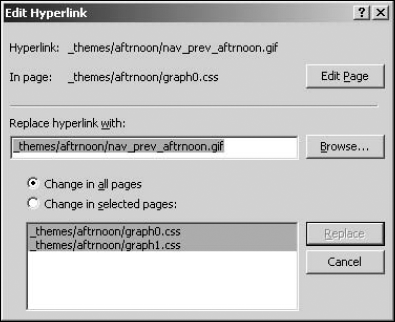25.2. Using Site-Reporting Features
SharePoint Designer allows you to generate a number of reports in the Reports pane. This section discusses some of the commonly used report views.
25.2.1. Files reports
If you choose Site ![]() Reports
Reports ![]() Files, a number of views for reports related to recently added, changed, and old files appear. In the Reports pane, you can switch between views by clicking the view name in the top-left corner. If you choose the Recently Added Files, Recently Changed Files, or Old Files menu option, a Days dropdown menu is enabled in the top-right corner of the Reports pane. You can use this dropdown menu to bypass the settings for days you made in the Reports View tab in the Application Options dialog box.
Files, a number of views for reports related to recently added, changed, and old files appear. In the Reports pane, you can switch between views by clicking the view name in the top-left corner. If you choose the Recently Added Files, Recently Changed Files, or Old Files menu option, a Days dropdown menu is enabled in the top-right corner of the Reports pane. You can use this dropdown menu to bypass the settings for days you made in the Reports View tab in the Application Options dialog box.
NOTE
The Checkout Status view is enabled for Web sites that support checking-in and checking-out files. For example, you can use the Checkout Status view for an FPSE site that has check-in/check-out enabled for it.
25.2.2. Shared content reports
The report views in this section focus on providing reports that can help developers understand the usage of various types of shared resources, such as master pages, style sheets, and dynamic Web templates. It also helps you create a report that indicates the pages in SharePoint sites that have been customized by using SharePoint Designer.
|
The following steps indicate how easy it is in SharePoint Designer to determine the number of customized pages in a SharePoint site:
Open a SharePoint site for which you want to know the amount of pages that have been un-ghosted or customized.
Choose Site
 Reports
Reports  Shared Content
Shared Content  Customized Pages to open the Customized Pages reports view.
Customized Pages to open the Customized Pages reports view.For each page that has been customized in SharePoint Designer, a Yes appears in the Customized column.
Filter the Customized column for Yes values.
Choose File
 Save As to save the report. You can also right-click a customized Web page in this report and then choose Reset to Site Definition from the popup menu to re-ghost them.
Save As to save the report. You can also right-click a customized Web page in this report and then choose Reset to Site Definition from the popup menu to re-ghost them.
|
25.2.3. Problems reports
The reports in this view can help you determine broken hyperlinks as well as components and pages that are considered slow:
Unlinked Pages: Shows the Web pages other pages on the Web site don't have hyperlinks to
Slow Pages: Shows the list of pages that are considered slow based on the settings in the Reports View tab in the Application Options dialog box
Hyperlinks: Generates a report of broken hyperlinks. When you switch to this view, SharePoint Designer tries to verify all hyperlinks for your Web site. If you click Yes, it tries to find out if the hyperlink is valid. The result of the validation shows in the reports view. You can also edit and fix broken hyperlinks by right-clicking on the broken hyperlink in the reports view and then choosing Edit Hyperlink from the popup menu. This opens the Edit Hyperlink dialog box, as shown in Figure 25.3, which allows you to specify the new hyperlink and then choose whether you want to make changes to this hyperlink on all pages or on selected pages only.
Components Errors: Determines if there are any errors on the various Web components being used on the Web site. The error is displayed in the Error column of the report.
Figure 25.3. Fixing broken hyperlinks using the Hyperlinks reports view


